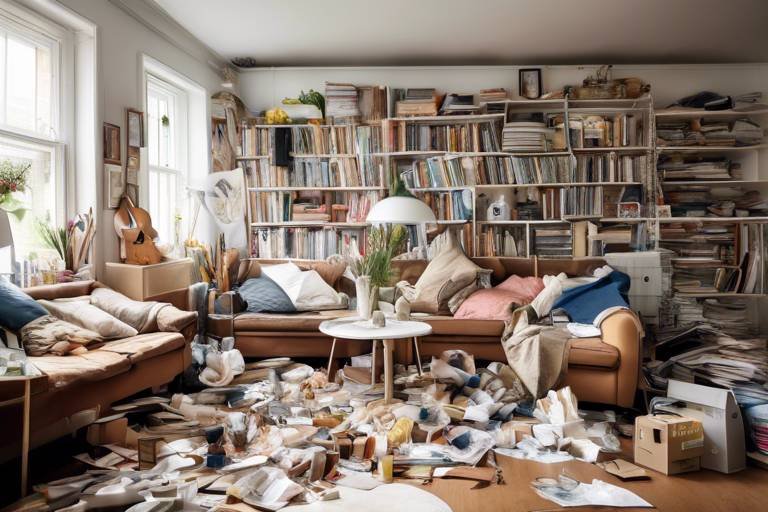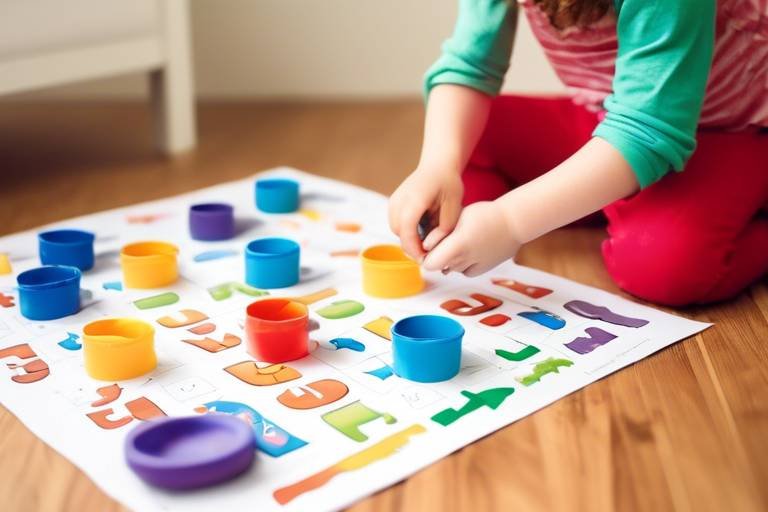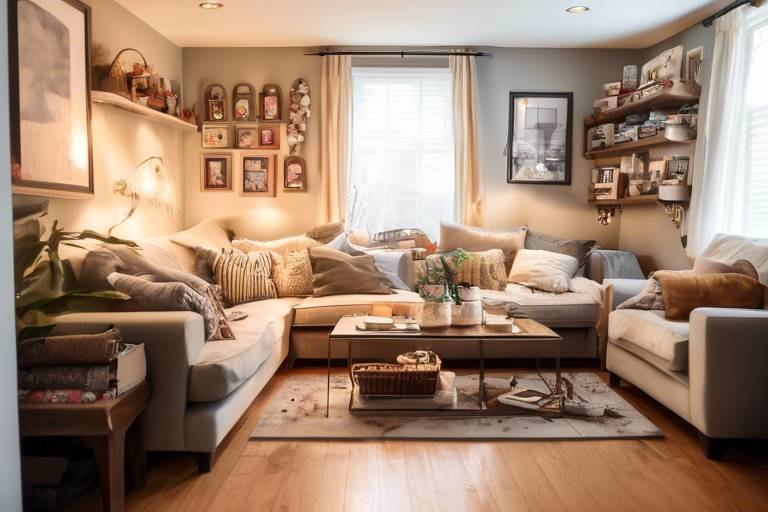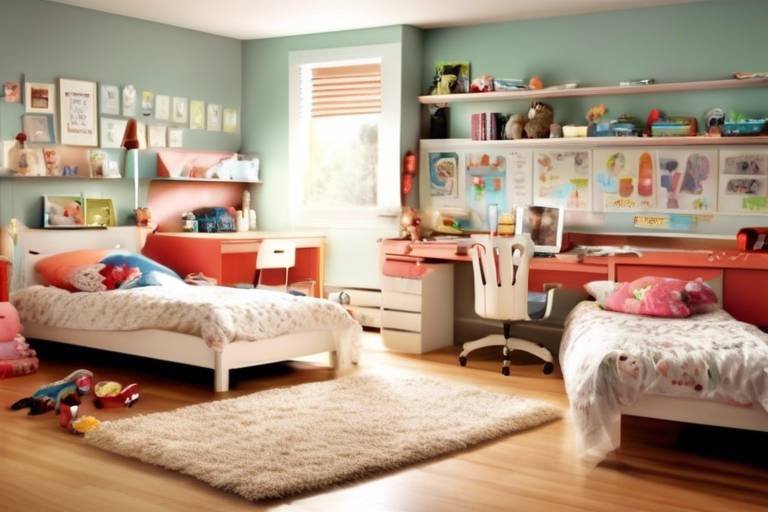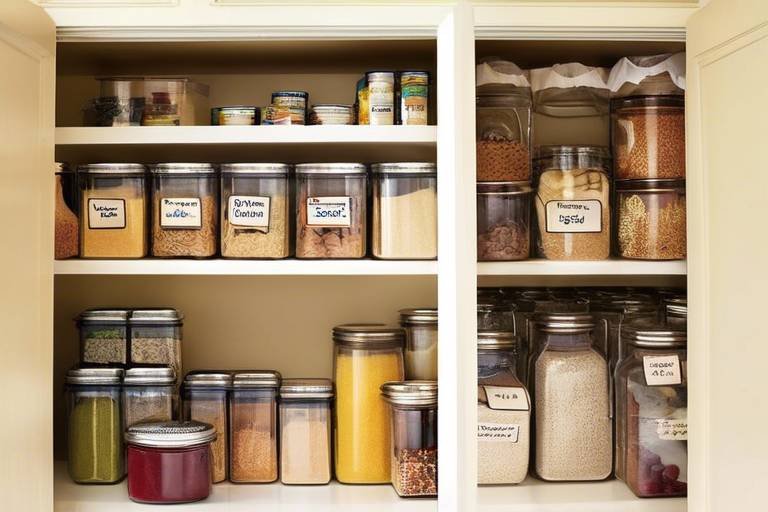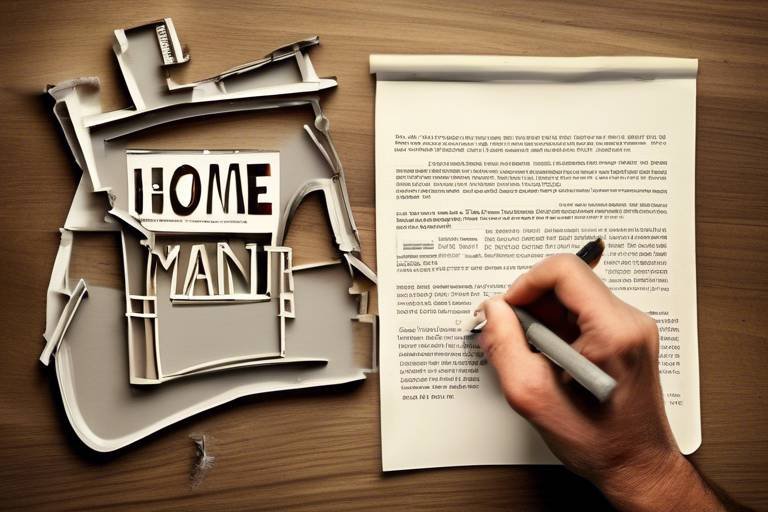The Magical Art of Tidying Up Your Home
Tidying up your home isn't just about cleaning; it's a transformative journey that can reshape your entire living experience. Imagine walking into your home and feeling an immediate sense of peace wash over you, like a gentle breeze on a warm day. This article explores effective tidying techniques, the psychological benefits of decluttering, and practical tips for creating a serene living space. Ultimately, we aim to help you transform your home into a sanctuary of peace and order.
Understanding the core principles of tidying can significantly impact your approach. It's not just about throwing things away; it’s about making conscious choices. Think of your home as a canvas, and every item as a brushstroke. When you learn to let go of what no longer serves you, you can create a masterpiece of tranquility. This section delves into the mindset shifts necessary for effective decluttering. Embracing the philosophy of tidying can enhance your overall well-being, making your space a reflection of your true self.
A tidy home offers numerous advantages that extend beyond mere aesthetics. It’s a powerful antidote to stress, a catalyst for improved focus, and a booster for productivity. When your surroundings are organized, your mind can breathe easier. Here, we discuss how organization contributes to a healthier lifestyle and a more positive mental state. Imagine waking up in a space that energizes you instead of weighing you down. That’s the magic of tidiness!
Decluttering can lead to emotional liberation, allowing individuals to let go of past attachments. It’s like shedding an old skin that no longer fits. This part examines how tidying can foster emotional healing and clarity in one’s life. When you declutter, you’re not just clearing physical space; you’re also making room for new experiences and emotions. It’s a chance to reconnect with yourself and your aspirations.
A clutter-free environment can significantly lower anxiety levels. Have you ever noticed how a messy room can feel like a weight on your shoulders? We explore the connection between physical space and mental health, providing insights into creating a calming atmosphere. By reducing visual chaos, you create a sanctuary where your mind can relax and focus on what truly matters. It’s about turning your home into a fortress of serenity.
A well-organized home can enhance self-esteem. It’s amazing how taking control of your space can translate into greater confidence in other areas of life. When everything has its place, you feel more in control of your surroundings, which can empower you to tackle other challenges. This section discusses how the act of tidying can inspire a sense of accomplishment, making you feel like you can conquer the world!
Effective tidying requires practical strategies. In this section, we outline various methods to declutter efficiently and maintain an organized home over time. Think of it as building a toolkit for a lifelong journey of tidiness. Whether it’s the famous KonMari method or the simple "one in, one out" rule, we’ll provide you with the tools you need to keep your space serene and orderly.
A structured plan is essential for successful tidying. It’s like having a treasure map that guides you through the clutter. Here, we provide step-by-step guidance on how to create a personalized decluttering roadmap tailored to your needs. Remember, this isn’t a race; it’s a journey. Take your time, and enjoy the process of discovering what truly matters to you.
Establishing clear goals is crucial for motivation. Think of your goals as the North Star guiding you through your tidying journey. This part discusses how to set achievable targets that will keep you focused throughout your tidying journey. Whether it’s decluttering one room at a time or spending just 10 minutes a day tidying, small steps can lead to significant changes.
Incorporating tidying into your daily routine can make a significant difference. Imagine if tidying became as automatic as brushing your teeth! We share practical habits that can help maintain an organized home effortlessly. By integrating simple tidying practices into your everyday life, you’ll find that keeping your space in order becomes second nature.
- How often should I declutter my home? It’s recommended to assess your space at least once a season, but daily tidying can help maintain order.
- What should I do with items I no longer need? Consider donating, recycling, or selling items to give them a second life.
- Can tidying really improve my mental health? Absolutely! A tidy environment can reduce stress and anxiety, promoting a sense of calm.

The Philosophy Behind Tidying
Understanding the core principles of tidying is like unlocking a treasure chest filled with not just physical space but also mental clarity and emotional freedom. Tidying isn't merely about organizing your belongings; it's about transforming your mindset. Imagine your home as a reflection of your inner self. When your surroundings are cluttered, it can feel like your thoughts are tangled in a web, making it hard to focus or find peace. By embracing the philosophy of tidying, you're essentially choosing to clear that web and create a serene space that nurtures your well-being.
At the heart of this philosophy lies the concept of mindfulness. Tidying encourages you to be present and intentional with your possessions. Instead of mindlessly accumulating items, you begin to ask yourself: Does this bring me joy? This simple question can be a game-changer. It empowers you to let go of things that no longer serve you, creating room for what truly matters. The act of decluttering becomes a ritual of self-reflection, allowing you to assess not just your belongings but also your values and priorities.
Moreover, tidying is not a one-time event; it's a lifestyle. Think of it as a journey rather than a destination. Embracing this philosophy means developing a sustainable approach to maintaining order in your life. You start to view tidying as a form of self-care, akin to exercising or eating well. It's about creating a nurturing environment that supports your goals and dreams.
To truly grasp the philosophy behind tidying, consider the following key principles:
- Letting Go: Recognize the emotional attachments you have to objects and be brave enough to release what no longer serves you.
- Intentional Living: Focus on what adds value to your life and surround yourself with items that inspire and uplift you.
- Consistency: Cultivate daily habits that reinforce your commitment to a tidy space, making it easier to maintain over time.
In summary, the philosophy behind tidying is about creating a harmonious space that reflects your true self and fosters a sense of peace and clarity. By shifting your mindset and embracing the principles of mindfulness, letting go, intentional living, and consistency, you can transform not just your home but also your life. So, are you ready to embark on this enlightening journey of tidying?
Q: What is the first step to start tidying my home?
A: Begin by assessing your space and identifying areas that feel overwhelming. Choose one small area to focus on first, such as a drawer or a corner of a room.
Q: How do I decide what to keep and what to let go?
A: Ask yourself if each item brings you joy or serves a practical purpose. If it doesn't, consider letting it go.
Q: Is tidying a one-time process?
A: No, tidying is an ongoing practice. Incorporate daily habits to maintain your space and prevent clutter from accumulating again.

Benefits of a Tidy Home
Imagine walking into your home after a long day, and instead of feeling overwhelmed by clutter, you are greeted by a sense of calm and order. A tidy home is not just visually appealing; it comes with a plethora of benefits that can enhance your overall quality of life. From reducing stress to boosting your productivity, the advantages of maintaining an organized space are numerous. When your surroundings are in harmony, your mind can also find peace, allowing you to focus on what truly matters.
One of the most significant benefits of a tidy home is the reduction in stress levels. Clutter can be a constant source of distraction, pulling your attention away from more important tasks. Studies have shown that individuals who live in organized environments report feeling less anxious and more in control. It’s almost as if a clean space allows your mind to breathe, releasing the tension that often accumulates in a chaotic environment. In fact, a survey conducted by the National Sleep Foundation found that people who keep their homes tidy tend to sleep better, which is crucial for maintaining good mental health.
Moreover, a tidy home can lead to improved focus and increased productivity. When everything has its place, you can find what you need when you need it, saving precious time that would otherwise be wasted searching for lost items. A decluttered workspace, for instance, can enhance your ability to concentrate on tasks without the constant nagging of visual distractions. Just think of it as a clear desk leading to a clear mind—a simple yet profound analogy that perfectly captures the essence of organization.
Another noteworthy benefit of maintaining a tidy home is the positive impact on emotional well-being. Decluttering can serve as a form of emotional liberation, allowing individuals to let go of past attachments and create space for new experiences. By removing items that no longer serve a purpose in your life, you not only create a more functional environment but also foster a sense of clarity and renewal. This emotional aspect of tidying is often overlooked, yet it plays a vital role in how we perceive our living spaces and ourselves.
To illustrate the benefits of a tidy home, consider the following table:
| Benefit | Description |
|---|---|
| Reduced Stress | A clutter-free environment helps lower anxiety levels, creating a sense of calm. |
| Improved Focus | Less distraction leads to enhanced concentration and productivity. |
| Emotional Clarity | Letting go of unnecessary items fosters emotional healing and renewal. |
| Better Sleep | Organized spaces contribute to a more restful sleep environment. |
In summary, a tidy home is more than just a visual preference; it is a vital component of a healthy lifestyle. By embracing the art of tidying, you not only create a serene living space but also pave the way for greater emotional and mental well-being. So, why not take the first step today? Start small, and you’ll soon discover that the benefits of a tidy home extend far beyond mere aesthetics.
- How often should I tidy my home? Regular tidying can prevent clutter from accumulating. Aim for a quick daily tidy-up and a more thorough declutter weekly or monthly.
- What should I do with items I no longer need? Consider donating, recycling, or selling items that are in good condition. This not only clears space but also helps others.
- Can tidying really improve my mental health? Yes! A tidy environment can significantly lower stress and anxiety levels, contributing to better emotional health.
- What are some quick tidying tips? Start with one room at a time, set a timer for 15 minutes, and focus on surfaces. Use storage bins to keep similar items together.

Emotional Well-being
Decluttering is not just about eliminating physical items; it’s a transformative journey that can lead to profound emotional liberation. Imagine walking into a space that feels heavy and cluttered, where every item whispers a memory or a past attachment. Now, picture that same space, but this time, it’s light, airy, and inviting. This shift can significantly enhance your emotional state, allowing you to let go of what no longer serves you.
When we hold onto items, we often carry the weight of memories and emotions associated with them. This can create a sense of stagnation in our lives. By engaging in the act of tidying up, we are not just organizing our physical space; we are also creating a metaphorical space for new experiences and opportunities. As we declutter, we make room for clarity and growth, allowing ourselves to move forward unencumbered by the past.
Furthermore, the emotional benefits of tidying extend beyond just the act itself. They can lead to a ripple effect in our lives. For instance, when you declutter your home, you might find that you feel more motivated to tackle other areas of your life, whether it’s pursuing a new hobby, improving your relationships, or enhancing your career. It’s like giving yourself the green light to embrace change and positivity.
Here are some key emotional benefits of decluttering:
- Increased Clarity: A tidy space can lead to a clearer mind, enabling you to think more effectively.
- Emotional Healing: Letting go of physical items can help release emotional baggage, leading to a sense of relief.
- Enhanced Focus: With fewer distractions around you, it becomes easier to concentrate on what truly matters.
In essence, decluttering your home is akin to shedding old skin. It’s about renewal, rejuvenation, and rediscovery of self. As you navigate through your belongings, you might find that you’re also navigating through your emotions. This process can help you identify what truly brings you joy and what merely occupies space. Remember, each item you choose to keep or let go of is a step towards creating a more fulfilling and emotionally balanced life.
So, the next time you feel overwhelmed by clutter, take a moment to reflect on how it impacts your emotional well-being. Embrace the journey of tidying up not just as a chore, but as an opportunity for emotional growth and a chance to reclaim your space and your peace of mind.
- How can decluttering improve mental health? Decluttering can reduce stress and anxiety, creating a more peaceful environment that promotes relaxation and focus.
- What should I do with items I decide to let go of? Consider donating, recycling, or selling items to give them a new life while helping others.
- How often should I declutter my home? It’s beneficial to declutter regularly, perhaps every few months, to maintain a serene and organized space.

Reducing Anxiety
Imagine walking into your home and feeling an overwhelming sense of calm wash over you. It's like stepping into a sanctuary where every item has its place, and chaos is nowhere to be found. This serene environment can be a powerful antidote to anxiety. Studies have shown that a clutter-free space can significantly lower anxiety levels, creating a peaceful atmosphere that promotes mental clarity. When our surroundings are organized, our minds tend to follow suit, allowing us to focus on what truly matters.
But how does a tidy home contribute to reduced anxiety? Well, think of your living space as a reflection of your mental state. When your home is cluttered, it can feel like you're carrying around an invisible weight. You may find it hard to relax, as your mind is constantly distracted by the mess. On the flip side, a clean and organized environment can help you feel more in control and less overwhelmed. It’s almost like hitting a reset button on your brain!
Here are some ways that reducing clutter can lead to a calmer mindset:
- Visual Clarity: A tidy space offers visual serenity, allowing your mind to focus without distractions.
- Reduced Decision Fatigue: Fewer items mean fewer choices, which can significantly decrease stress levels.
- Enhanced Productivity: An organized environment boosts your ability to concentrate, leading to better performance in tasks.
Moreover, the act of decluttering itself can be therapeutic. As you sort through items, you're not just organizing your space; you're also processing emotions tied to those belongings. Letting go of items that no longer serve you can lead to a sense of liberation and relief. This emotional release can be incredibly beneficial, allowing you to move forward without the weight of past attachments holding you back.
To illustrate the connection between a tidy home and reduced anxiety, consider this simple table:
| Cluttered Home | Tidy Home |
|---|---|
| Overwhelming visual stimuli | Calm and organized environment |
| Difficulty concentrating | Enhanced focus and productivity |
| Increased stress levels | Reduced anxiety and stress |
Creating a calming atmosphere doesn’t have to be a daunting task. Start small by dedicating just a few minutes each day to declutter. You’ll be amazed at how even minor changes can lead to major shifts in your mental well-being. Remember, every little bit counts, and the journey to a serene home is a marathon, not a sprint.
In conclusion, reducing anxiety through tidying up your home is not just about aesthetics; it’s about creating a nurturing environment that promotes peace and tranquility. So why not take that first step today? You deserve a space that reflects the calm you wish to feel inside.
- How often should I declutter my home? It's recommended to declutter regularly, ideally every few months, to maintain a tidy space.
- What if I feel overwhelmed by the amount of clutter? Start small! Focus on one area at a time, and celebrate your progress.
- Are there specific items I should focus on decluttering? Yes! Consider items that you haven't used in the past year or that don't bring you joy.

Boosting Confidence
Imagine walking into your home and feeling a wave of positivity wash over you. A well-organized space can do just that! When your surroundings are tidy, it’s like a breath of fresh air that lifts your spirit and boosts your confidence. You might not realize it, but the state of your home reflects your mental state. If your space is chaotic, it can lead to feelings of overwhelm and inadequacy. On the flip side, a neat and orderly environment provides a sense of control and accomplishment, making you feel more capable and empowered.
When you take the time to declutter and organize your home, you’re essentially sending a message to yourself: “I can manage my space, and by extension, my life.” This newfound sense of control can ripple out into other areas of your life, enhancing your self-esteem and encouraging you to tackle challenges with a renewed zest. It’s like the domino effect of positivity! For instance, you might find yourself taking on new projects at work or engaging more actively in social situations, all because you feel good about your space.
Moreover, when your home is tidy, it creates a welcoming atmosphere for guests. You can invite friends over without the anxiety of hiding piles of clutter or feeling embarrassed. This openness can lead to stronger relationships, as you feel more comfortable sharing your space and, by extension, your life with others. Here are some ways a tidy home can specifically boost your confidence:
- Sense of Accomplishment: Each time you complete a tidying task, it reinforces your ability to achieve goals.
- Enhanced Focus: A decluttered space allows for clearer thinking, helping you make decisions with confidence.
- Improved Mood: A clean environment can elevate your mood, making you feel more positive and self-assured.
In essence, tidying up is not just about organizing your belongings; it’s about transforming your mindset. When you take control of your environment, you cultivate a space that reflects the best version of yourself. So, the next time you find yourself surrounded by clutter, remember: it’s not just about the mess; it’s about reclaiming your confidence and embracing the life you want to lead.
Q: How often should I declutter my home?
A: It’s a good practice to declutter regularly, perhaps every season or whenever you notice things piling up. Consistency is key!
Q: What should I do with items I no longer want?
A: Consider donating, recycling, or selling items. This not only clears your space but also helps others.
Q: Can tidying really affect my mental health?
A: Absolutely! A clean and organized space can reduce stress and anxiety, leading to improved emotional well-being.

Practical Tidying Techniques
Tidying up your home might seem like a daunting task, but with the right practical techniques, it can become a rewarding journey rather than a chore. Think of your home as a canvas, and decluttering as the brush strokes that will reveal a masterpiece of organization and tranquility. One of the most effective methods to start is the KonMari Method, which encourages you to keep only those items that "spark joy." This philosophy not only simplifies the process but also transforms the way you view your belongings. Imagine walking into a room and feeling an overwhelming sense of peace rather than chaos; that’s the power of tidying!
Another practical technique is the Two-Minute Rule. If a task takes less than two minutes to complete, do it immediately. This could be as simple as putting away a book or wiping down a counter. By tackling these small tasks right away, you prevent clutter from accumulating, which can lead to a more organized space. It’s like watering a plant regularly; if you do it consistently, you’ll see it flourish instead of wilting under neglect.
In addition to these methods, creating a designated spot for everything is crucial. When every item has its place, it becomes second nature to put things away. You can visualize this as a well-organized toolbox: every tool has its designated slot, making it easy to find what you need when you need it. To help you get started, consider implementing the One In, One Out Rule: for every new item you bring into your home, let go of one. This keeps your belongings in check and ensures that your space remains manageable.
To maintain your newly tidied space, it’s vital to establish daily tidying habits. Set aside just 10 minutes each day to declutter a specific area. You could tackle a drawer, a shelf, or even your desk. This small commitment can lead to significant changes over time. Imagine the satisfaction of a clean, organized space without the stress of a massive cleanup looming over you!
Lastly, consider involving the whole family in the tidying process. Make it a fun activity where everyone contributes to creating a serene environment. You could turn it into a game, where each family member has a specific area to tidy, and at the end of the session, you can celebrate your collective efforts. This not only lightens the load but also fosters a sense of teamwork and shared responsibility.
- What is the best way to start decluttering? Begin with a small area or category of items to avoid feeling overwhelmed.
- How often should I tidy my home? Aim for daily tidying habits, but do a deep clean at least once a month.
- Can tidying really improve my mental health? Yes, a tidy environment can lead to reduced stress and anxiety levels.
- What if I struggle to let go of items? Focus on the joy and purpose each item brings to your life and remember that letting go can lead to new opportunities.

Creating a Decluttering Plan
Creating a decluttering plan is like mapping out a treasure hunt; it requires strategy, patience, and a clear vision of what you want to achieve. To embark on this journey, you need to first understand that a structured plan is essential for successful tidying. Think of it as your personal roadmap, guiding you through the maze of your belongings. Without a plan, you might find yourself overwhelmed and unsure of where to start. So, let’s break it down into manageable steps that can help you transform your space into a haven of peace and order.
Start by assessing your current situation. Take a good look around your home and identify areas that need the most attention. Is it the overflowing closet, the cluttered kitchen counter, or perhaps the chaotic garage? By pinpointing these hotspots, you can prioritize your efforts and tackle the most pressing issues first. This is crucial because it sets the tone for your decluttering journey and helps you feel accomplished as you check off completed areas.
Next, establish clear and achievable goals. Goals are like the fuel that keeps your decluttering engine running. They provide motivation and a sense of direction. For instance, instead of saying, “I want a tidy house,” you might set specific targets like, “I will declutter my bedroom by the end of the week” or “I will donate five bags of clothes this month.” These defined goals make the process less daunting and give you a tangible way to measure your progress.
Once you have your goals in place, it’s time to create a timeline. Consider how much time you can realistically dedicate to decluttering each day or week. Maybe you can spare an hour after work or a couple of hours on weekends. Whatever it is, stick to your schedule as best as you can. Consistency is key! If you can, break your tasks down into smaller chunks. For example, instead of trying to declutter your entire living room in one go, focus on one section, like the coffee table or a single shelf.
As you dive into the decluttering process, remember to be kind to yourself. It’s easy to get caught up in the emotional attachments we have to our belongings. If you find it difficult to let go of certain items, ask yourself a few questions: Does this item bring me joy? Have I used it in the past year? If the answer is no, it might be time to say goodbye. You can even create a “keep,” “donate,” and “discard” system to simplify your decision-making process. This way, you can categorize your items and make the decluttering experience less overwhelming.
Finally, maintain your newly organized space by incorporating daily tidying habits. This is where the magic happens! Set aside a few minutes each day to put things back in their designated places. You might be surprised at how easy it is to keep clutter at bay once you make tidying a habit. Consider designating a specific spot for everything, so you always know where to find your belongings. Remember, a tidy home reflects a tidy mind, and this simple practice can lead to a more serene and productive lifestyle.
In conclusion, creating a decluttering plan is not just about getting rid of stuff; it's about making room for what truly matters in your life. By following these steps and embracing the journey, you can transform your home into a sanctuary of peace and order. So grab your checklist, roll up your sleeves, and get ready to uncover the beauty hidden beneath the clutter!
- How long does it take to declutter a home? The time it takes varies based on the size of your home and the amount of clutter. Setting aside a few hours a week can lead to significant progress over time.
- What should I do with items I want to donate? Research local charities or organizations that accept donations. Many will even pick up items from your home!
- Can decluttering really improve my mental health? Absolutely! A tidy space can reduce stress and anxiety, creating a more peaceful environment for you to thrive in.

Setting Goals
When it comes to tidying up your home, is like drawing a map before embarking on a journey. Without a clear destination, you might find yourself wandering aimlessly through the clutter, feeling overwhelmed and frustrated. So, how do you establish effective goals that will keep you motivated throughout your decluttering adventure?
First and foremost, it’s essential to identify what you want to achieve. Are you looking to create more space, reduce stress, or simply find that lost treasure buried under piles of stuff? Whatever your reasons, having a clear vision will serve as your guiding star. It's like having a beacon that illuminates your path, making it easier to navigate through the chaos.
Next, consider breaking your larger goals into smaller, more manageable tasks. Think of it as slicing a big cake into bite-sized pieces. For instance, instead of saying, “I want to declutter my entire home,” you might set a goal like, “I will declutter my bedroom this weekend.” This approach not only makes the task seem less daunting but also gives you a sense of accomplishment as you check off each smaller goal.
To help you visualize your goals, you can create a decluttering checklist. Here’s a simple example:
| Room | Goal | Deadline | Status |
|---|---|---|---|
| Bedroom | Declutter closet | Friday | In Progress |
| Living Room | Organize bookshelves | Next Monday | Not Started |
| Kitchen | Clear countertops | Next Wednesday | Not Started |
As you work through your goals, remember to stay flexible. Life happens, and sometimes your plans may need to change. If you find that a particular area is taking longer than expected, don’t beat yourself up. Instead, adjust your timeline and keep moving forward. This flexibility is key to maintaining motivation and ensuring that tidying up doesn’t become another source of stress.
Lastly, celebrate your achievements, no matter how small. Did you just clear out a drawer? Give yourself a little pat on the back! Setting goals is not just about the end result; it’s also about enjoying the journey. Each step you take towards a tidier home is a step towards a more peaceful and organized life. So, grab a cup of tea, take a moment to appreciate your progress, and get ready to tackle the next challenge!
- What should I do if I feel overwhelmed by the clutter?
Start small. Focus on one area at a time, and set achievable goals to make the process manageable. - How can I maintain my tidying efforts over time?
Incorporate daily tidying habits into your routine and regularly review your decluttering goals. - Is it necessary to get rid of everything I don't use?
No, focus on keeping items that bring you joy or serve a purpose. It's about finding balance.

Daily Tidying Habits
Incorporating daily tidying habits into your routine can transform your living space from chaotic to calm in no time. Imagine waking up each day to a home that feels organized and serene. It’s like starting each morning with a clean slate, ready to tackle whatever the day throws at you. But how do you make this a reality? It all begins with small, manageable habits that can be seamlessly integrated into your daily life.
One of the most effective daily tidying habits is the 10-Minute Tidy. Set aside just ten minutes each day—perhaps right before bed or after breakfast—to focus on decluttering a specific area. This could be as simple as clearing off a cluttered countertop or organizing a drawer. The beauty of this habit lies in its simplicity; ten minutes is short enough that it feels achievable, yet it can make a significant impact over time. You might be surprised at how much you can accomplish in just a few minutes!
Another powerful habit is the One In, One Out rule. This principle is straightforward: for every new item you bring into your home, you must remove one. This helps prevent accumulation and encourages mindful purchasing. Think of it as a balancing act; if you’re adding something new, you’re also letting go of something old. This practice not only keeps your space tidy but also fosters a sense of intentionality in your choices.
Additionally, consider establishing a “clutter catch-all” basket in your home. This is a designated spot for items that don't have a proper place. Instead of letting clutter pile up on surfaces, simply toss items into the basket throughout the day. At the end of the week, take a few minutes to sort through it and put things where they belong. It’s a great way to keep your home looking tidy without feeling overwhelmed by the process.
Moreover, making your bed each morning can set the tone for a tidy day. A made bed instantly makes your room feel more organized and can motivate you to keep the rest of your space in order. It’s a small task that can have a big impact on your mindset. Think of it as a symbolic gesture of taking control of your environment—a simple action that can inspire you to tackle more significant tidying tasks.
Finally, don’t underestimate the power of a nightly reset. Before you wind down for the evening, take a moment to do a quick scan of your living space. Put away any items that are out of place, fluff up the pillows, and tidy up any surfaces. This little ritual can help you wake up to a fresh environment, making it easier to start your day on the right foot.
Incorporating these daily tidying habits into your life doesn’t have to be daunting. Start with one or two that resonate with you, and gradually build upon them. Remember, the goal isn’t perfection; it’s about creating a home that feels peaceful and inviting. By making tidying a part of your everyday routine, you’ll find that maintaining a serene living space becomes second nature.
Q: How long does it take to see results from daily tidying habits?
A: The results can vary based on your starting point and the habits you choose to adopt. However, many people notice a significant difference within a few weeks of consistent practice.
Q: What if I don’t have time for daily tidying?
A: Even just a few minutes a day can make a difference. You can also combine tidying with other daily activities, like tidying while you cook or during commercial breaks while watching TV.
Q: Can tidying really impact my mental health?
A: Yes! A tidy environment can reduce stress and anxiety, improve focus, and create a more positive living space. It’s all about creating a sanctuary that nurtures your well-being.
Frequently Asked Questions
- What is the best way to start decluttering my home?
Starting your decluttering journey can feel overwhelming, but a great tip is to begin with one small area, like a drawer or a closet. Set a timer for 15-30 minutes and focus solely on that space. This makes the task manageable and gives you a sense of accomplishment when you see the results.
- How do I decide what to keep and what to discard?
When deciding what to keep, ask yourself if the item brings you joy or serves a practical purpose. If it doesn't, it might be time to let it go. Remember, decluttering is about creating a space that reflects who you are now, not who you were in the past.
- Can decluttering really improve my mental health?
Absolutely! A tidy space can lead to reduced stress and anxiety. When your environment is organized, it can help clear your mind, making room for positive thoughts and creativity. It's like breathing fresh air after being in a crowded room!
- How often should I declutter my home?
It's a good idea to declutter regularly—think of it as a seasonal refresh! Some people find that a quick tidy-up every month works wonders, while others prefer a more thorough declutter a couple of times a year. Find a rhythm that suits your lifestyle.
- What are some daily habits to maintain a tidy home?
Incorporating small daily habits can make a big difference. Try the 'one in, one out' rule: for every new item you bring home, let go of an old one. Additionally, spend 5-10 minutes each day putting things back in their designated spots. It’s like giving your home a quick hug!
- Is it necessary to have a decluttering plan?
While not strictly necessary, having a plan can significantly enhance your decluttering process. A structured roadmap helps you stay focused and motivated, making it easier to tackle larger areas without feeling lost or overwhelmed.

